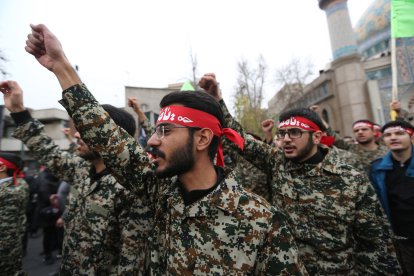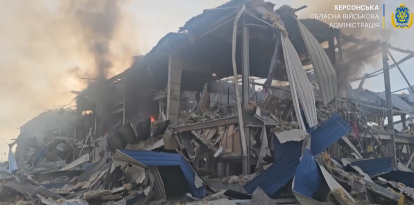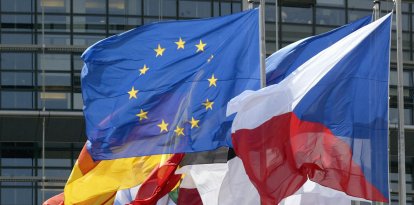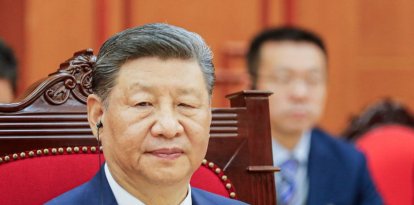How Iran funds terrorism and its wars around the world, especially against Israel
A report by The Economist revealed that Iran channels tens of billions of dollars from illicit oil sales into bank accounts around the world. This is how the Oct. 7 massacre and the country's nuclear program were financed.

Members of the Revolutionary Guard Corps. in Tehran, Iran.
British publication The Economist published a report revealing Iran's secret, meticulously crafted process for financing terrorism and its wars around the world.
Every year, Iran funnels tens of billions of dollars from illicit oil sales into bank accounts all over the globe. These resources were used to finance the Oct. 7 massacre perpetrated by Hamas and other terrorist groups in southern Israel in 2023, as well as Russian drones in Ukraine and the Iranian nuclear program, which concerns the West.
Iran's oil economy
Just after the Trump administration withdrew the United States from the nuclear deal between Iran and other world powers in 2018 and reimposed sanctions aimed at curbing Iranian oil exports, the Islamic Republic's crude oil sales plummeted.
Since then, however, they have grown twelvefold. In fact, in 2023 the Iranian regime collected between $35-50 billion, while petrochemical exports provided an extra $15-20 billion to Iran.
How does the Iranian regime smuggle oil and launder billions of dollars?
The Economist's investigation revealed that Iran has built extensive clandestine financial channels, ranging from its oil rigs to the virtual vaults of its central bank. It added that China, the Iranians' main client, is an architect of this system and its main beneficiary.
The Economist indicated that global banks and financial centers are used as important parts of this system, although they are generally unaware of it.
A source consulted by the British outlet revealed that as of last July, Iran had $53 billion, 17 billion euros (currently valued at $18.3 billion) and smaller amounts in other currencies abroad.
U.S. sanctions aimed at curbing Iran's nuclear program and its funding of terrorism, which even apply to companies in the United States and other countries that knowingly trade with Iran, make it difficult for the regime to receive and move dollars, since transactions must be processed by a U.S. bank. However, Tehran can circumvent these obstacles.
The system is complex and requires meticulous work. The National Iranian Oil Company (NIOC), its state-owned oil company, has a monopoly on production, while NIOC's subsidiary, called Naftiran Intertrade Company (NICO), which is based in Switzerland, helps market oil abroad. However, a significant portion is allocated to ministries, religious organizations and even pension funds to sell it themselves.
In Iran, a country that is submerged in a deep economic crisis and where foreign currency is in short supply, crude oil is an alternative form of liquidity and is distributed among its military, certain individuals loyal to the regime and the Revolutionary Guard Corps. All of them are also allowed to sell and make profits, which can be in the billions.
Sometimes shell companies are used. In fact, the firm Sahara Thunder, located in Iran, handles sales for the military pretending to be a private firm, the U.S. Treasury Department said.
While China absorbs 95% of Iran's crude exports, its state-owned companies do not want to get involved for fear of sanctions, which is why Iran uses a handful of shell companies to scour the market. Beijing, meanwhile, has its own brokers, whose clients supply plants that the state has authorized to process Iranian oil. Most are small, independent refineries.
Once a buyer is found, a formal agreement is signed, usually involving two shell companies.
Contracts often avoid stating the true origins of the oil and indicate that it comes from other countries, such as Malaysia, Oman or Iraq. The actual origin is often confirmed by a confidential letter.
The route of the tankers
A source revealed to The Economist that there are more than 100 front companies procuring tankers. In many cases, these are old ships flagged in Panama, due to it being a permissive port, and the vessels are renamed to confuse trackers.
The boats start the journey by picking up oil at one of Iran's export terminals. To avoid attention, they often lend transponders to other ships in the area, or use software to make it look like they are somewhere else. They then head to Iraq or Oman, where they transfer the cargo to a new ship. In addition, another shipment transfer may occur off the coast of Malaysia or Singapore, and then it heads to China.
Throughout the process, certificates of origin and false documents are provided.
This process is not straightforward, so problems can arise, such as the detection of these vessels by U.S. forces or Western intelligence services when they are stopped or seized. However, while these setbacks affect the process, they do not stop it completely, as the system is well-organized and prepared for these types of inconveniences.
China, a key player in the process
To pay for oil, China usually keeps the money in local accounts to purchase goods or finance other operations. In addition, there are trading companies around the world, especially in Turkey and the United Arab Emirates, that help funnel the money back to Iran, often disguised as legitimate payments.
Money laundering, explained The Economist, takes place in multiple steps. From Chinese and Turkish bank accounts, funds can be transferred to others in tax havens or in banks that are not under strict supervision. At the end of the process, the money goes back to Iran, or stays out to fund military operations, terrorist groups or even Iran's own infrastructure in other countries.
The Economist also detailed the role of currency exchanges in Iran. These firms keep track by maintaining internal ledgers: giant spreadsheets that offset debits and credits across hundreds of trusts. Their clients, Iranian firms, liquidate positions by buying or selling virtual dollars through an online platform called NIMA, usually at subsidized exchange rates. Although the hard currency remains outside the country, it is ultimately owned by the Central Bank of Iran, which manages NIMA.
As a source familiar with the matter told The Economist, the Iranian Central Bank has its own spreadsheet for recording the virtual reserves it holds abroad. The report added that while the system is well organized, it is very costly, so Iran gets between 30-50% of what it would get in the open market.
The Economist concluded that this secret Iranian system is "an affront to the West, a boon to China—and a menace to the world."
RECOMMENDATION





















